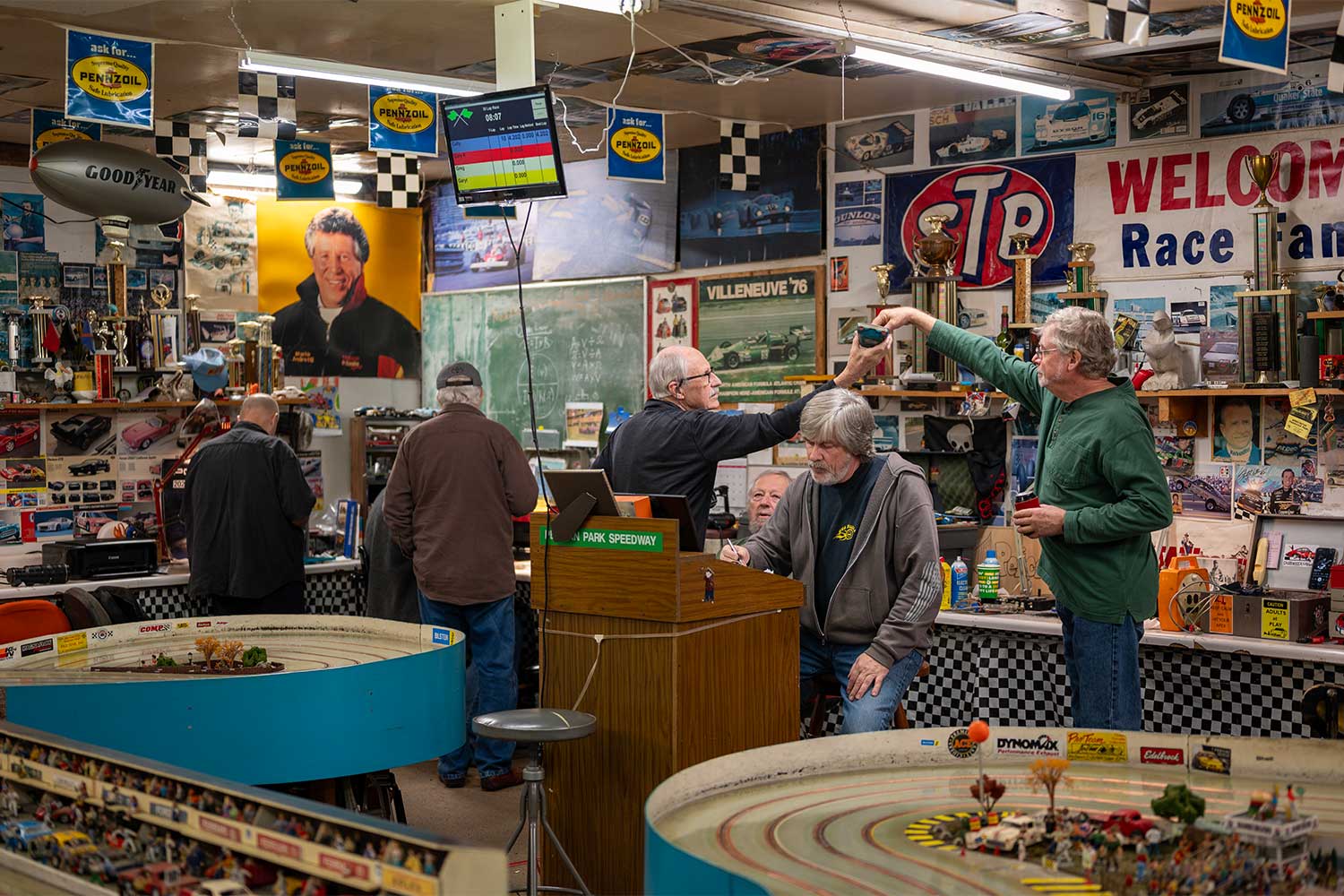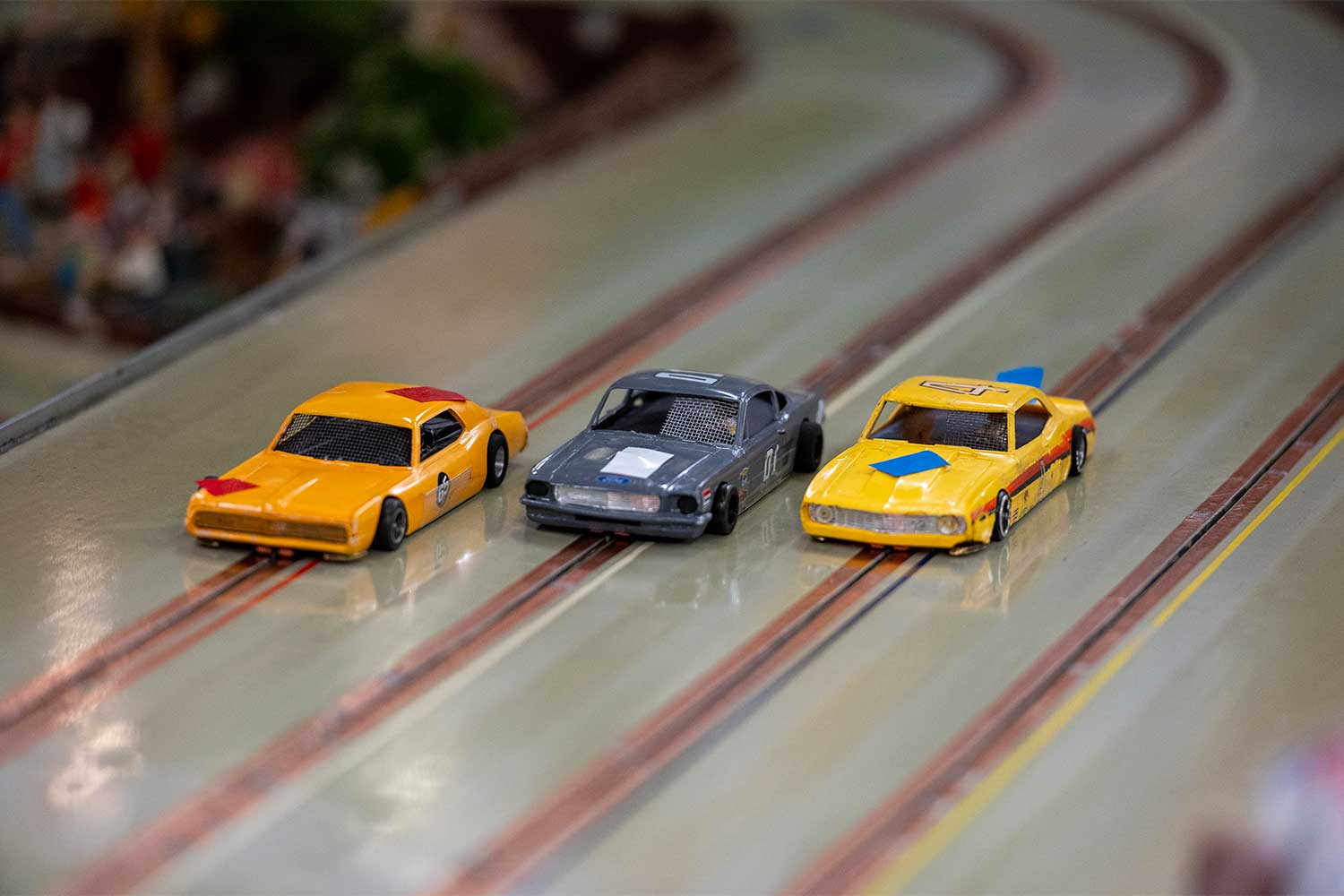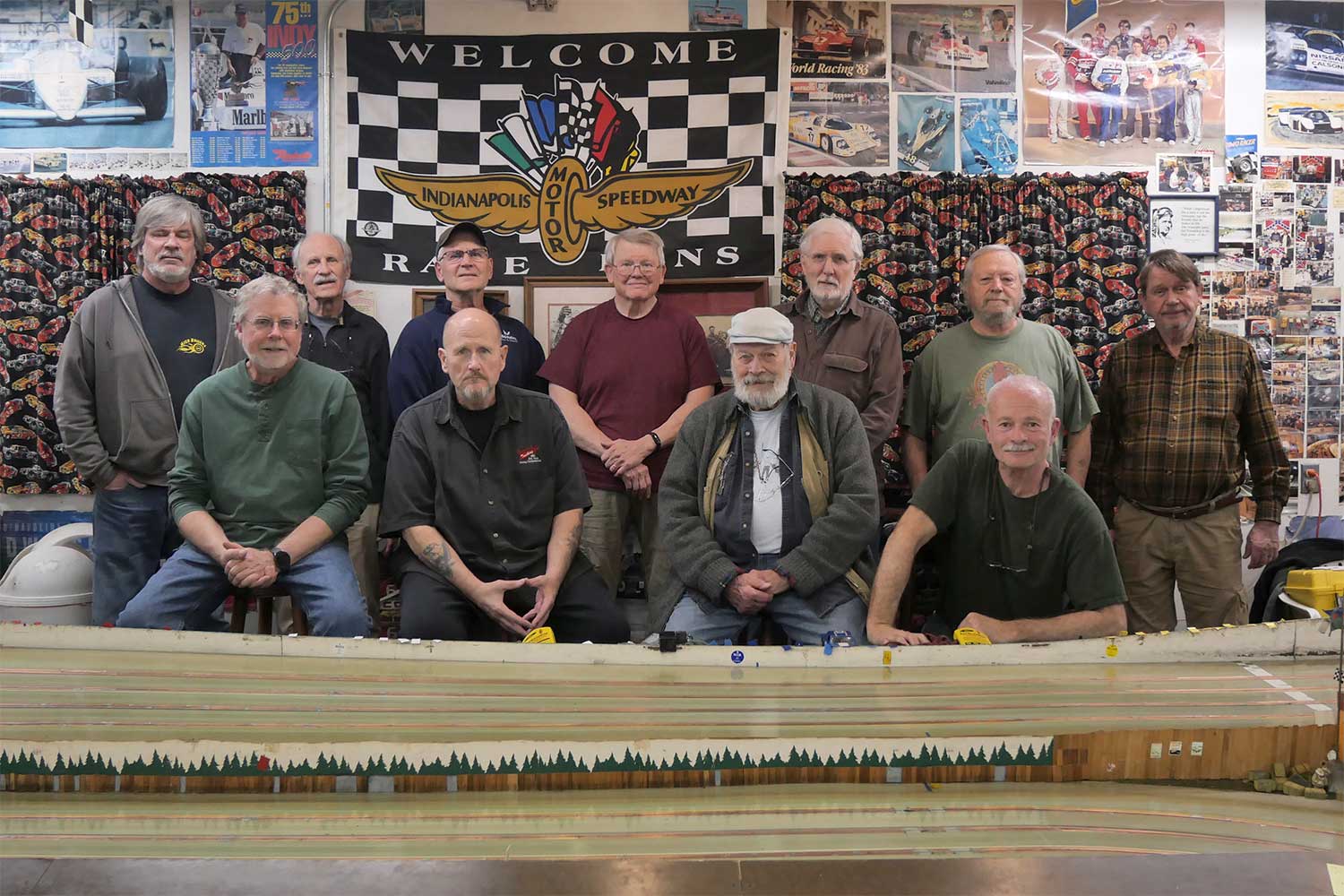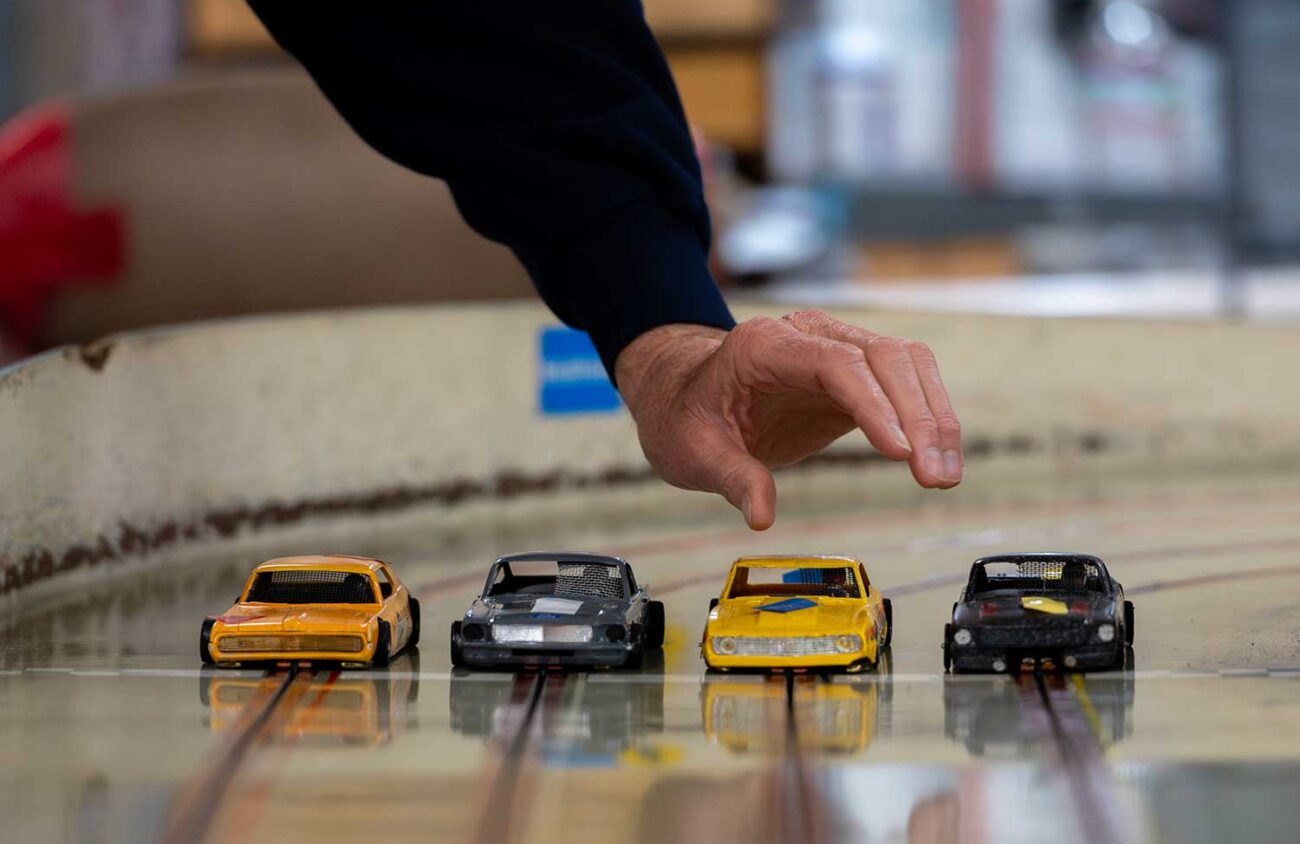I was told to follow a club member from the Springfield Albertsons on Main Street to the secret hideout. When the club wouldn’t give me the address, I thought my kidneys were going to be harvested. Instead, following Tom Snyder, 84, down a set of winding back roads, I felt this experience could go either way — organ harvesting or cool hidden clubhouse.
Unfortunately, the odds of either happening still seemed 50/50 when I pulled up to the Pelican Park Speedway, an externally rundown looking garage I was told used to be a small body shop, with a view of mountains and suburban sprawl.
Snyder exited his car, pulled out a cane and walked over and introduced himself. He then explained the history of Pelican Park, which has been rented since 1996 by a few of the members — an era that predated Oregon’s legalization of cannabis.
Initially, the group members, who are all in their 60s or older, met in secret as they also smoked weed at meetings and didn’t want to get caught. They met to race slot cars — small model vehicles on specially designed tracks powered by electric motors. The name comes from the small slots or grooves on the track that a pin or blade from the car is inserted into to power it.

The members still meet to hang out, smoke, race and honor the memories of previous members of the Pelican Park club — who Snyder refers to as “10 or 12 retired gear-head men who gather weekly for fierce but happy competition.”
In the clubhouse — where my initial impressions were blown out of the water and any fear of kidney robbery was dismissed — Snyder regaled me with tales of the beginnings of the club, which was founded by Doug Haynes, who died in 2009. Another notable deceased member, who died in 2019, was Todd Messinger. Messinger housed a massive collection of slot cars, and apparently built a new one every week. The final name mentioned for late racers was Dave Frazier, who passed away in 2022.
Slot cars began in the early 1900s with the invention of the toy by Lionel Corporation. However, the little race cars as we see them today, powered by electric motors and current from the track, gained popularity in the 1960s, according to Italian artisan slot car maker, NSR. The Pelican Park club launched officially in 1989.
The Pelican Park clubhouse is a dream for all things automotive. Bits of art and photographs of famous racing drivers, such as Bruce McLaren and Enzo Ferrari, line the walls with photos of previous and current club members added among the photographic collages.

Diecast and model cars line large book shelves along the edges of Pelican Park. Racing hats and small trophies break up the rows of model car after model car. A car aficionado myself, I have dreamed of a man cave this meticulous and overt at displaying all things with four wheels and a combustion engine.
The centerpiece of it all is the race track. Pelican Park’s track is on the smaller side, according to Snyder, who explained that many of the tracks he grew up with were far larger. Multiple bends, a straightaway and an overpass comprise the majority of the track.
Slot cars are built on a variety of scales — 1/24 means that the small cars are 1/24th the size of a real race car. Snyder says Pelican Park races “1/24 and 1/25th scale ‘hard body’ slot cars where the bodies are converted from 1/24th and 1/25th scale plastic model car kits from the hobby shop or online.”
Each corner of the track is populated by a diorama of figures and miniatures, sometimes performing unsavory, but funny, acts. The raceway has its own personality, one that amalgamates each members’ personal taste. When it comes to the race itself, a better lap result — the difference between winning and losing — comes down to the weight of the car, understanding of the track, aerodynamics and simple skill.

The display of previous members’ cars holds emotional significance to the surviving racers, says Paul Lanz, 70. “It’s how we like to honor our former racers and friends.”
Lanz inherited Messinger’s previous collection and pared it down, keeping the best examples for display. “Todd had 250 cars. He gave me all of his unbuilt models. I sold off a lot of them though,” Lanz says.
Two other members, who’d arrived earlier to help set up the track were Greg Pierson, 73, part of the original group in 1996, and Cully Bowman, 63, who joined in 1999. They were re-soldering electrical contact points along the track as well as wiping it down with copious amounts of lighter fluid to remove grease and spent silicone from the cars’ tires.
Snyder explained the night’s racing class. Out of 13 classes, the night’s specialty was “modified dirt,” which Snyder, with a drag on his Camel described as “one of our fastest classes. It’s a bit loose with the rules, which is to say other classes aren’t.”
Bowman chimed in saying each night is “the systematic destruction of your works of art. And no crying!” Destruction of a slot car is usually due to running off the track or winding up in a collision. Notably, Snyder explained the slot cars they race can cost anywhere from $5 to $250, but they tend to limit the usage of their more expensive models.
A few more members entered the fray: Gary Klein, 74, who joined in 2016. Gary Tipton, also 74, joined in 2016 after racing in Albany from 2010 to 2015. Charlie Snyder, 81, Tom’s brother, who’s been racing since the start and acts as the group’s parts liaison. Chris “Basil” Snyder, 67, another Snyder brother. Deke Coleman, 68, who’s been racing since he was 8, and finally James Wendel, 74, who joined up in around 2012.
With the racers all set, and their workshop kits assembled along the benches lining the walls, the qualifier races quickly set into motion.
Placement in the qualifiers is dictated by a random drawing of numbers, with two groups of four racing for placement in the eventual main event, although, there is a loser’s category lovingly referred to as the “consi” or consolation race. The bottom two racers from either qualifier populate the loser’s bracket, and the top four racers populate the main event.

The prize? Doughnuts. White, powdered sugar doughnuts.
Each race begins by grabbing the attention of the racers with a recording of a goat scream — a quirk of Pelican Park. The scream is followed by a countdown, which is also visible on a small TV hung from a ceiling rafter. Snyder says, “The goats were stocking-stuffers from last Christmas, and who knew how funny they would be when we initiated our ‘On your mark, get set, go!’ beginning each heat race!”
The racing is exhilarating.
Each slot car can reach nearly 60 miles an hour on straightaways, according to a few of the members — a speed narrated by the whir of their electric motors, which Charlie Snyder, the aforementioned parts liaison, provided with a price tag of $23.50 each. Charlie Snyder is able to purchase the motors from a wholesaler in Roseburg, and delivers the parts to the members at races.
The 1/24 scale models rip around through bends and corners, sometimes with their rear ends stepping out in either direction. Every so often, a car leaves its designated lane, but any of the members not racing are readily available to replace the car so it can continue its heat.
Each heat lasts 50 laps with an average lap speed of 4.7 seconds, although I saw a lap as quick as 4.441 seconds, posted by Tipton. “He’s the man to beat,” a few of the other racers said.
Interspersed between heats is the occasional smoking session, be it cigarettes or marijuana, but they’re never long breaks.
Ultimately, at the end of the night, despite who wins and who loses, there’s always companionship. Lanz put it best: “We come together and put aside life differences and political opinions because we just want to race.”
“At the end of the day, the guy that beat your ass that night will probably tell you how to beat his ass next week,” he says.
For more information on Pelican Park Speedway, contact Tom Snyder, 541-953-8951 or mitexihb@gmail.com.
